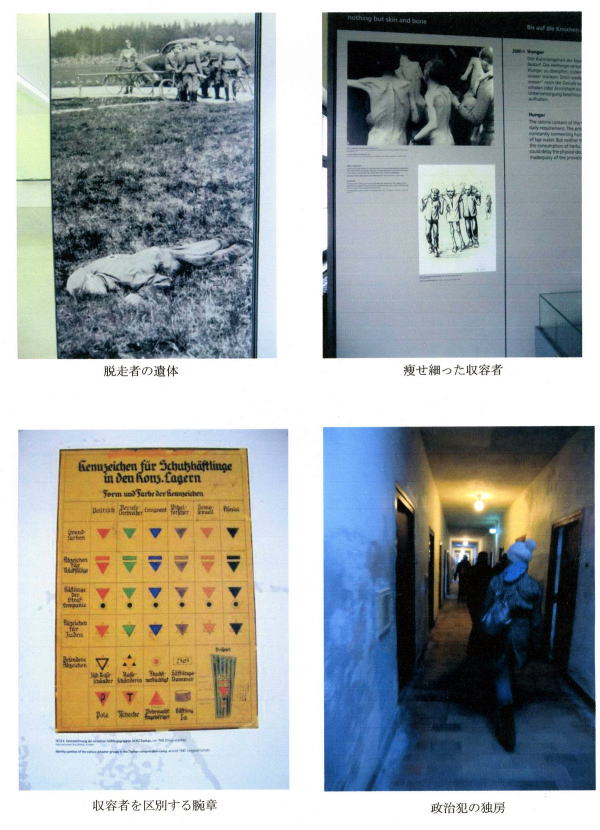
I applied for "a Dachau Concentration Camp, the walking tour" of the local tour on the Internet and gathered in front of the city hall of the Marien open space of Munich at 10:15 a.m. on Tuesday, December 20, 2011.
As for the participant of the tour, 16 Americans (pro-parents with their children, primary schoolchild one), Spaniard six, Japanese were one me, groups of 23 people in total. The tour guide speaks English in Germans.
There was the Dachau concentration camp trace which Hitler bodyguards managed in those days by bus from the station square that arrived at Dachau Station from Marien pl. Station to S barn 2 in approximately around 20 minutes to approximately ten minutes.
I intended to borrow a Japanese earphone guide in an administration office, but there was not it. I got an English pamphlet and entered at the entrance of the then SS Troops watchtower.
There was the の letter which ARBEIT MACHT FREI ""fitted freely by working"" in the gate of the grate of the entrance. I felt terror on a letter same as the Polish Auschwitz camp gate.
The camp became the present, the museum, and a then state was displayed with a photograph and a document vividly. The first building is the place that prisoners brought here undress in the administration, and is examined.
The Nazi Administration establishment and the later movement were displayed with an enlarged photograph successively. All the guidance in the hall speaks it in guide English in German or English, besides.
As for the displayed photograph, miserable things were arranged as I advanced. I did the health that people forced to life at a camp, given poor clothes, poor room, all the inmates became thin, and lost weight.
As for the human being that time of Auschwitz and the same thought revive as for me in front of the photograph of the heap of bodies like the mummy of people treated like garbage, can it be cruelly to why here? … .
In addition, a documentary film was shown in the hall and edited the genuine film which was really photographed with the work for around 20 minutes when I featured the theme of Jew-baiting under the Nazi Administration.
Furthermore, the cells such as political offenders taken at first formed a line in a row when I advanced, and the political offense, the clergyman who objected to the policy of the Nazis were able to watch the state that accommodated isolation as a national enemy.
It is two womens, dining room, for each one for work, experiment on a human body institution one, ward 13 soon the barrack institution of 34 that prisoners contain in the very large site of the camp trace outside the museum.
It becomes the museum which two accommodation ridges are restored now, and reproduces those days. Only a base expressing a building is left to the trace.
At the crematory burning up the body, be divided into two institutions. The gas chamber was located within big one, but did not seem to be really used.
There was the image which it was written that I told the garden of the crematory institution "to remember how crematory we died here".
In addition, there was the church of the many denominations which were made since a camp was released in a site, and there was the avenue lined with poplar trees where inmates planted it midmost of the accommodation ridge.
It was felt to be very wintry by snow that has just started. As for the front that passed through the avenue lined with poplar trees, the monument of the group of the people who I get twisted up to be able to shave barbed wire made in front of the center of the museum in 1997 in a motif, and writhe, the Jewish mark that three images and star type overlapped aside … .
The visit of approximately around three hours.
What kind of thought would the の letter, the inmate whom ARBEIT MACHT FREI published at the entrance "fitted freely by working" watch this in?

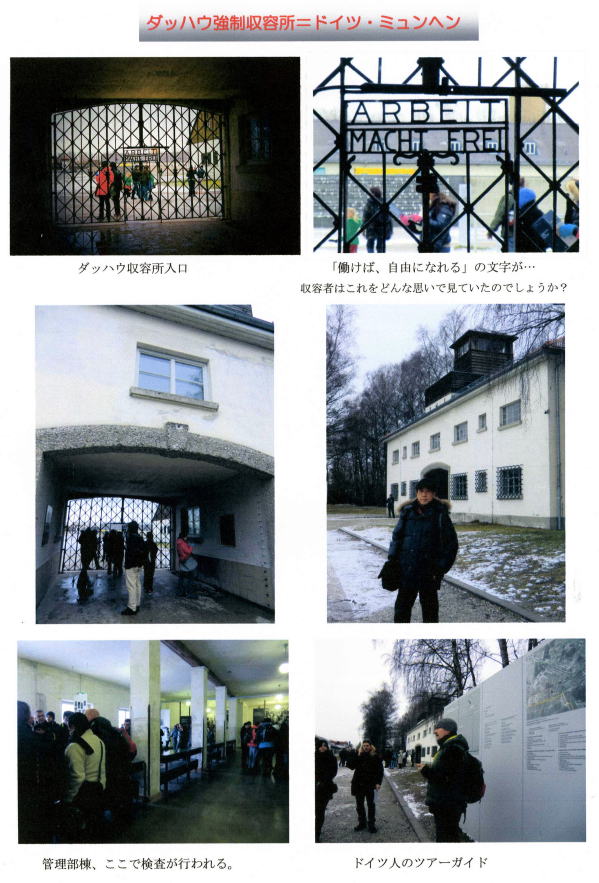

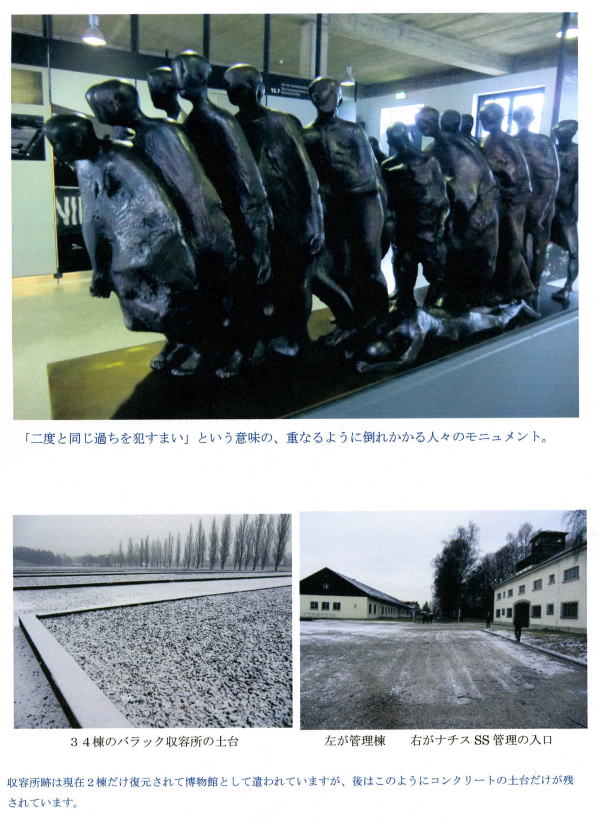
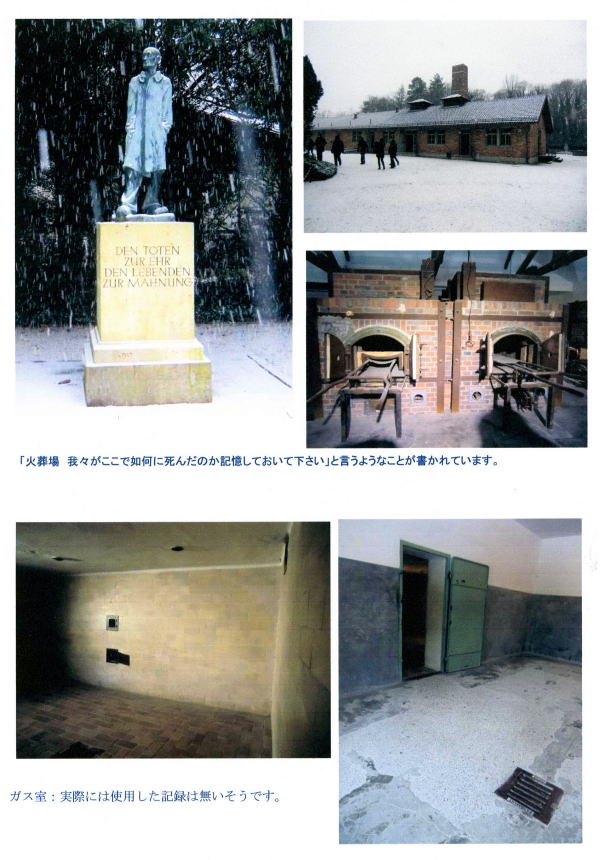


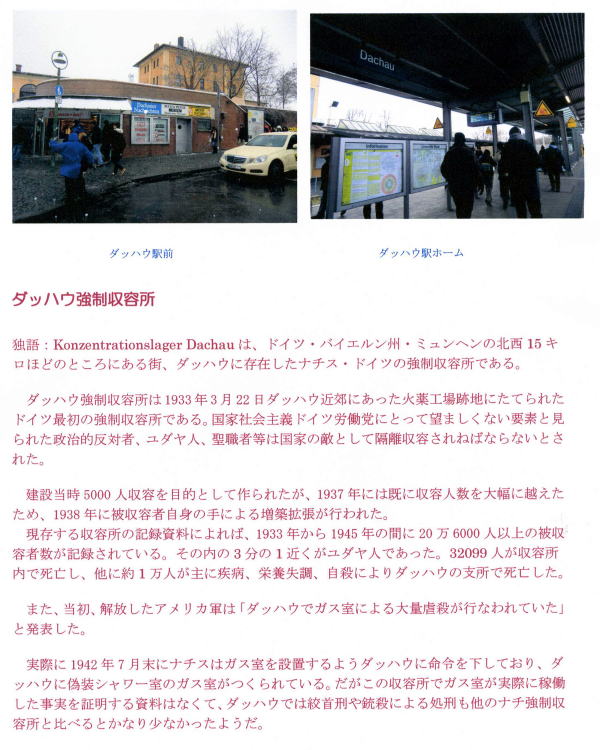

ダッハウ強制収容所博物館 PHOTO ALBUM
私はインターネットで現地ツアー「ダッハウ強制収容所、ウォーキングツアー」を申し込み、現地時間の2011年12月20日(火)午前10時15分にミュンヘン・マリエン広場の市庁舎前に集合した。英語のツアーで、参加者はアメリカ人16人(親子連れで小学生1人)、スペイン人6人、日本人は私だけの合計23人の団体だった。ツアーは公共機関を使用し、ガイドはドイツ人で英語を話す。
マリエンプラッツ駅からSバーン2に乗り、約20分位でダッハウ駅に着く、駅前からバスで約10分のところに、当時ヒトラー親衛隊が管理していたダッハウ強制収容所跡はあった。
管理事務所でイヤホンガイドを借りようと思ったが、日本語は無。英語のパンフレットを貰い、当時のナチス親衛隊監視塔の入り口から入る。
収容施設は二重に鉄条網が張られ、バンカーも掘られ監視塔がいくつも存在した。その入口の鉄格子の門にはARBEIT MACHT FREI 「働けば自由になれる」の文字があった。ポーランドのアウシュビッツ収容所門と同じ文字に恐ろしさを感じた。
現在は博物館になっていて、当時の様子が写真と資料の数字で生々しく展示してあった。建物の最初は当時「管理部」で、ここで連れてこられた囚人たちが、裸になって検査を受ける場所で、写真を見ると現在自分が立っている場所と同じ場所であることに気付く…。
博物館の最初の展示はドイツ国家社会主義の台頭とその権力樹立の過程に関する記録文書だった。
続いてナチス政権樹立とその後の動きが拡大された写真で展示されていた。館内の案内はすべてドイツ語か英語で、しかもツアーは英語、残念ながら私の英語力では説明された内容の半分以上は理解不能で、写真で見る以上の理解は出来なかった。
展示されている写真は進むにつれて悲惨なものが並べられていた。
収容所で生活を強いられている人々、与えられた粗末な服、粗末な部屋、収容者は皆やつれてやせ細った体をしていた。首をつって自殺した人、人体実験のため頭をわられ脳を検査されている人、射殺された人等、目を背けたくなるような記録写真であった。
ゴミのように扱われている沢山の人々のミイラのような死体の山の写真を前に、私はアウシュビッツの時と同じで、人間は何故ここまで残虐になれるのか…。そして、犠牲者の絶望や苦しみ、叫びが聞こえる!何故こんな恐ろしい時代があったのだろう…。今でも何処かで同じように虐待・虐殺を繰り返す権力者達がいるのではないだろうか、決して人の人権を侵害するようなことはあってはならないと…。そして「二度と同じ過ちを犯すまい」という、重なるように倒れかかる人々のモニュメント。
また、ホールでは記録映画が上映されていて、ナチス政権下でのユダヤ人迫害をテーマとした20分位の作品で、当時実際に撮影された本物のフィルムを編集したものであった。
さらに進むと、当初の政治犯などの独房がズラリと並び、ナチスの政策に反対する政治犯、聖職者等は国家の敵として隔離収容した様子がうかがえた。
博物館の外には収容所跡の広大な敷地に、囚人たちの収容する34棟のバラック施設、そのうち婦人用2棟、食堂、作業用各1棟、人体実験施設1棟、病棟13棟。今では収容棟2棟が復元され当時を再現する博物館になっている。跡は建物を表す土台だけが残っている。
死体を焼却する、火葬場では、二つの施設に分かれていて。大きい方には、ガス室もあったが、実際には使用はされなかったようだ。火葬場施設の庭に「火葬場 我々がここで如何に死んだのか記憶しておいて下さい」と言うようなことが書かれた像があった。
また、敷地内に収容所が解放されてから造られたいくつもの宗派の教会があり、収容棟の真ん中には収容者達が植えたポプラ並木もあった。折からの雪でとても寒々しく感じられた。そのポプラ並木を抜けた正面、博物館の中央前に、1997年作られた有刺鉄線をモチーフに、それに絡まってもがき苦しんでいる人々の群像のモニュメント、その横に、三画や星型が重なり合ったユダヤのマークも…。
約3時間位の見学。入口に掲げられたARBEIT MACHT FREI 「働けば自由になる!」の文字、収容者はこれをどんな思いで見ていたのだろうか…私は雪が降りしきる中、犠牲者を追悼し、深く強く考えさせられた。
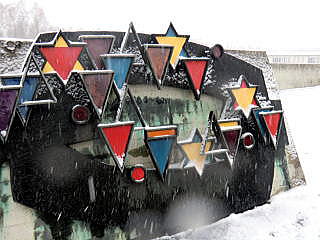
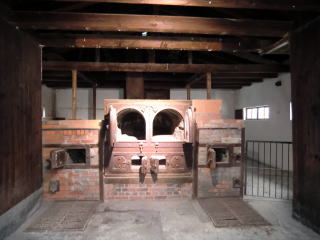

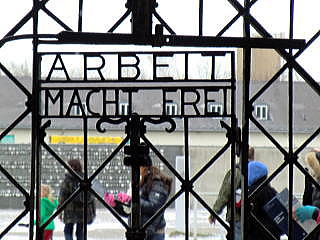
2011.12.20